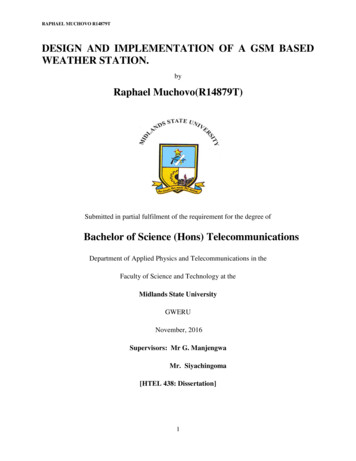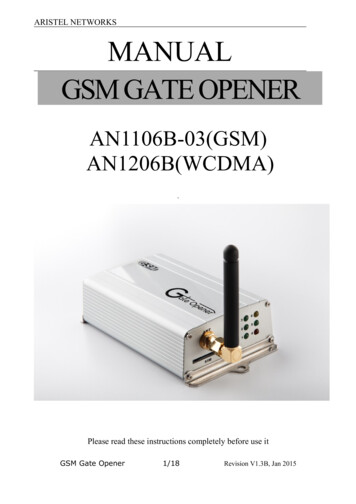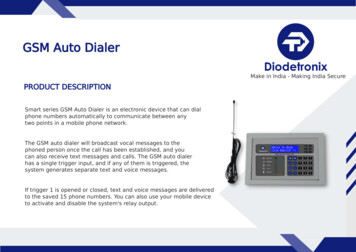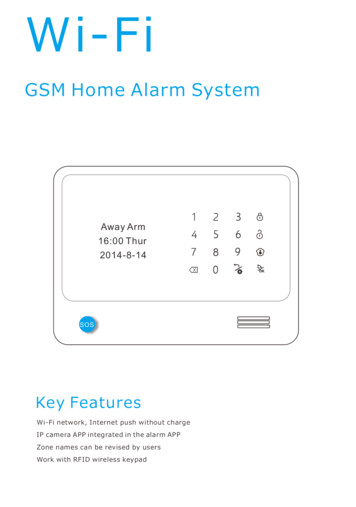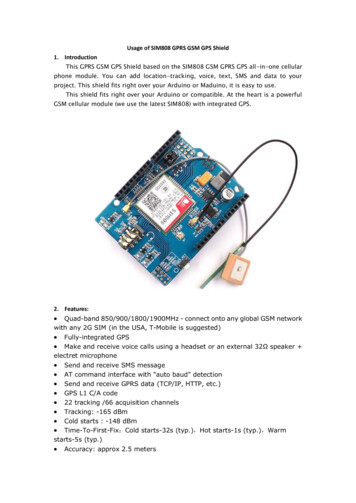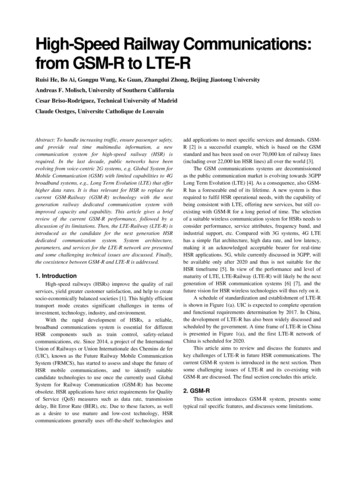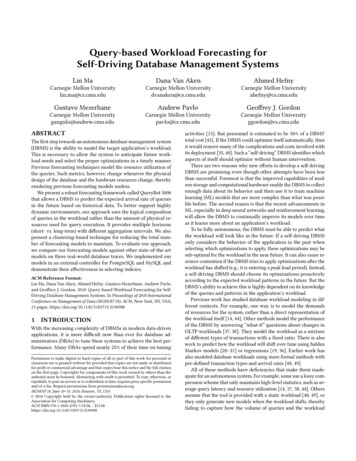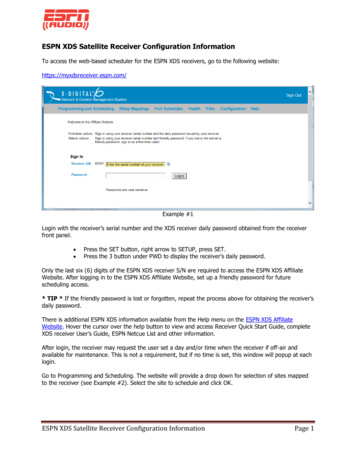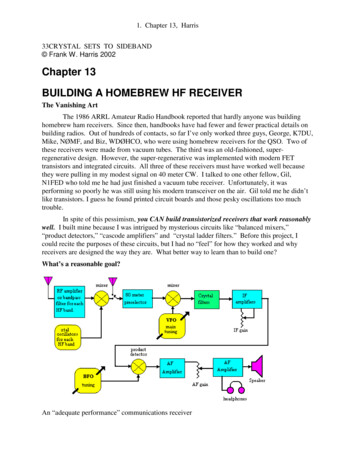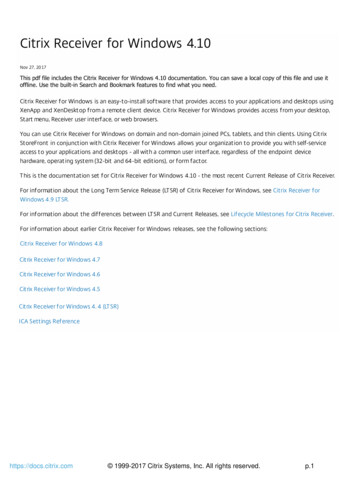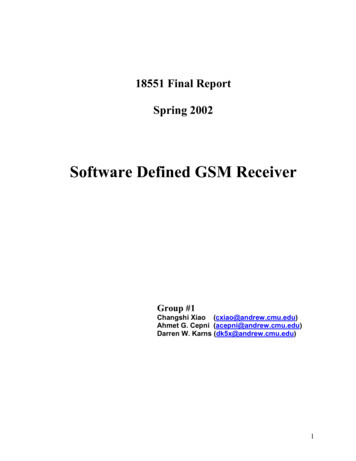
Transcription
18551 Final ReportSpring 2002Software Defined GSM ReceiverGroup #1Changshi Xiao (cxiao@andrew.cmu.edu)Ahmet G. Cepni (acepni@andrew.cmu.edu)Darren W. Karns (dk5x@andrew.cmu.edu)1
I. Introduction:In this project, we implemented a software-defined GSM receiver on the TI TMS320C67DSP EVM. First, we implemented the whole GSM transmitter and receiver processes onMatlab, and then we translated part of the receiver process onto the EVM board. As for thedemo, we tried to process speech signal and demodulate it on EVM board, and get the speechback from a speaker. The speech encoding was done on Matlab, the encoded bit stream wastransferred to Agilent Digital Signal Generator to generate standard GSM signals, then theanalog GSM signal was captured by Vector Signal Digitizer, the sampled baseband I&Qchannel signals were stored into a file, and then block by block sent to EVM board fordemodulation. We also modeled a wireless channel, which had Additive White GaussianNoise (AWGN) and small-scale Rayleigh fading, and compared the performance ofdemodulation under different Signal-to-Noise (SNR) values and different fading conditions.This report is organized as flowing: in section II, we’ll give some overview of GSM standardand the concept of Software Defined Radio (SDR), which is a hot research area in the last tenyears. In section III, we’ll introduce more about our system architecture. In section IV, we’llgive some details of the algorithm we implemented. In Section V, we’ll give some simulationresults with various channel models.II. GSM specifications and Software Defined Radio (SDR)GSM (Global System of Mobile communications) is the first digital wirelesscommunication standard originated in Europe in 1982, but soon became a global standardbecause of its popularity. The first GSM is operating at 900 MHz, and then upgraded twice to1800 MHz and 1900 MHz separately. Here in this project, we only introduce GSM900; thetechnical specification is shown below.GSM-900 SpecificationDownlink935-960 MHzUplink890-915 MHzChannel Sapcing200 kHzModulationGMSKTypical Mobile Transmit Power3.7 mW to 1 WMaximum BaseStation Transmit Power320 WMaximum Distance35 kmSpeech EncodingLPC (13kbit)Bit rate270 kpbs2
The basic system flow diagram is showed in Fig. 1. After converting the analog speechsignals into digits, the raw source bits are coded according to the model of human speech toreduce the bits needed to be transferred. Depending on the relative importance of the bits, thechannel coding function arranges the bits into blocks and adds some error correction codes.The encoded bits are then applied to interleaver, which shuffles the bit positions in the blocksto provide some time-diversity in fading channels. The interleaved bit blocks are assembledwith some training bits, and control bits to form normal speech GSM bursts, which aremodulated by GMSK modulation technique before sending to RF amplifier and antenna. Theprocess in the receiver side is the reverse of the transmitter. Plus, since the channel is notperfect, there always exists degradation of signal by noise, fading, doppler shifting, etc., sosome sort of channel equalization and noise filtering is needed to recover the original AccessBurst DisassemblingDeModulation/EqualizationFigure 1: Complete GSM system1GSM frame structure:There are two frequency bands of 25 MHz each that have been allocated for the use ofGSM. The band 890 - 915 MHz is used for the uplink direction (from the mobile station tothe base station). The band 935 - 960 MHz is used for the downlink direction (from the basestation to the mobile station). By FDMA, the frequency band is divided into 200 kHzsubbands, and by TDMA, each subband is divided into 120ms multiframes, and eachmultiframe is divided into 26 frames, the first two frames are used for controlling channel,and the rest are for traffic channel, and again, each frame is divided into 8 time bursts, eachof which is approximately 0.577 ms. In GSM, there are 4 different types of bursts. A normal1GSM technical specs:Theodore Rappaport, Wireless Communications, Principles& Practice, Prentice Hall, 1996.3
burst is used to carry speech and data information. The structure of the normal burst is shownbelow.Each burst consists of 3 tail bits at each end, 2 data sequences of 57-bits, a 26-bit trainingsequence for equalization, and 8.25 guard bits.There are 2 stealing bits (1 for each data sequence) that are used by Fast Access ControlChannels. The frequency correction burst and synchronous burst have the same length asnormal burst. They have different internal structures to differentiate them from normal bursts.The frequency correction burst is used in Frequency Correction Channels (FCCH) and thesynchronous burst is used in Synchronization Channels (SCH). The random access burst isshorter than a normal burst, and is only used on Random Access Channels (RACH).Uplink spectrumguard bandcarrier 1890MHzcarrier 2 carrier 124200kH915MHz120ms multiframeframe 1frame 2frame 3 .frame 26controlburst 1burst 2 burst 80.577msFigure 2. GSM frame structure, uplinkSource Encoding/DecodingRELP MotivationIn mobile communications systems, bandwidth is a precious commodity. The goal of allspeech coding systems is to transmit speech with the highest possible quality using the leastpossible channel bandwidth. The lower the bit rate at which the coder can deliver qualityspeech, the more speech channels can be implemented within a given bandwidth. Residual4
Excited Linear Predictive Coding, RELP, offers low bit rate speech coding that can be usedto meet this challenge2.Speech coders are broadly classified into two categories: Vocoders and Waveform Coders.Vocoders are a class of speech coding systems that analyze the voice signal at the transmitter,transmit parameters (spectral coefficients) derived from the analysis, and then synthesis thevoice at the receiver using those parameters. Vocoders are much more complex thanWaveform Coders, but they are less robust and their performance tends to be talkerdependent. The most popular vocoding system is Linear Predictive Coding, LPC.RELP TransmissionIn the RELP approach, standard LPC analysis yields the spectral coefficients. The number ofspectral coefficients, L, is predetermined. These spectral coefficients are then used tosynthesize the original speech3.LPC AnalysisLPFDecimationVoiceConversionto bitsFigure 3: Speech codingThe synthesized speech is then subtracted from the original speech to form a residual signal.The residual signal is then low pass filtered to extract a baseband signal from the residualsignal. The baseband residual sequence is then decimated. The decimation factor controlsthe amount of compression in the encoding process. The baseband residual sequence, theLPC coefficients and the first L original speech values are then coded to bits and transmitted.At the receiver, the received signal is first interpolated back to its original sampling rate.This interpolated signal is full-band reconstructed through nonlinear distortion. Only thehigh frequencies need to be reconstructed since the baseband signal is sent intact. Toaccomplish this high frequency regeneration, the interpolated signal is full wave rectifiedfollowed by a double differencing operation. The resulting signal is high pass filtered usingthe same cutoff frequency as the low pass filter used in transmission. Now the basebandinterpolated signal is added with the high frequency signal to produce the residual sequence.2Lots of tutorial information and matlab/C code for voice codinghttp://www.eas.asu.edu/ spanias/index.html3Lots of tutorial information for LPC voice 5
InterpolationHigh FrequencyRegenerationHPFReconstruction hFigure 4: Speech decodingUsing the spectral coefficients that were transmitted, the L original values and the residualsequence the original speech is reconstructed4.Channel Encoding/ DecodingA major feature of digital data transmission is the myriad techniques used to protect data orspeech through coding. Coding adds additional bits to the original payload to provide ameans of protecting the original information. This gives the data more security, since it ispossible to identify and even correct (within certain limits) data corrupted in the RF path5.The purpose of the channel encoder is to provide the GSM receiver with the ability to detecttransmission errors and eventually correct some of these. This is to improve the transmissionquality from a bit error point of view. Various encoding standards are used in GSMdepending on the mode of transmission. The encoding implemented on Matlab was bursttype TCH/FS (Traffic Channel Full rate Speech), which is a normal speech, burst. After thespeech coding, the bits are grouped in blocks of size 260. Out of 260 bits, the first 50 bits arecalled Class Ia bits, the next 132 bits are Class Ib bits and the last 78 bits are Class II bits (seeFig. 5). This ordering was done based on the importance of the bits. For instance, anytransmission errors in the class Ia bits effect the overall speech quality more severely thanerrors in class II bits. Due to this variation in bit importance the different classes of bits areencoded accordingly6.4Source code for GSM 06.10 RPE-LTP algorithmhttp://www.ddj.com/documents/s 1012/ddj9412b/A detailed discussion on channel encoding/interleaving in GSM systems:Siegmund Redl , An introduction to GSM , Artech House ,Inc. 1995.6Matlab codes for various channel encoding/decoding schemes:J. Proakis, M. Salehi, Contemporary Communication Systems using Matlab, BookWareCompanion Series.56
Input260 bitsClass IClass II182 bits78 bitsClass IaClass Ib50132ParityencoderConvolutionalencoder503Parity check bits 132 37878Output456 bits{0000}Tail BitsFigure 5: Channel Encoding in GSMThe 50 most significant bits (Class Ia bits) are parity encoded. The parity encoder used inGSM is a systematic cyclic encoder based on three check bits. Systematic means that theparity bits are added to the original class Ia bit sequence. This way the class Ia bits are leftunchanged 3 extra parity check bits are added to the end of the Class Ia bits.The generator polynomial used in the parity encoder has a length of 4 bits and is given asG(x) x3 x 1. After parity encoding of Class Ia bits, the resulting 53 bits are combined withClass Ib bits, and a tail sequence of four zeros are added to the block. The total number ofbits is 189, and this block is sent to convolutional encoder. The convolution encoder takes ablock of k bits as input and returns a block of n bits as output. The rate of the encoder,defined as the ratio k/n , is in the GSM system specified to be 1/2 . In the convolutionalencoding scheme each output bit, cn is depending not only on the input bit presently beingencoded, bk, but also on some of the previous input bits. The number of input bits required inthe processing of encoded output bit is called the constraint length of the encoder. GSMspecifies a constraint length of 5 in its encoding scheme defined as:C2k bk bk-3 bk-4C2k 1 bk bk-1 bk-3 bk-4 Mod 2 additionk {0,1,2,3, .189} and bk 0 for - k 0 n1As the convolution encoder is defined as a rate ½ encoder two output bits are generated forevery input bit, hence the two expressions. After convolutional encoding, 378 bits aregenerated out of 189 input bits, and they are combined with Class II bits to produce theoutput of the channel encoding. The input to the channel encoder has a block length of 260bits, and the output of the encoder is 456 bits long7.7“Digital cellular telecommunications system, Channel coding” GSM TechnicalSpecification. GSM 05.03 version 5.2.0, August 1996. Publication of the ETSI.7
Convolutional decoding can be performed using a Viterbi algorithm. A Viterbi decoderlogically explores in parallel every possible user data in sequence. It encodes and compareeach one against the received sequence and picks up the closest match: it is a maximumlikelihood decoder. To reduce the complexity (the number of possible data sequence doublewith each additional data bit), the decoder recognizes at each point that certain sequencescannot belong to the maximum likelihood path and it discards them. The encoder memory islimited to K bits (5 in GSM channel decoder); a Viterbi decoder in steady-state operationkeeps onlypaths. Its complexity increases exponentially with the constraint length K.The channel decoder implemented in Matlab reverses the operation done in the channelencoder6.InterleavingThe interleaver shuffles the bits contained in the data blocks that are coming from thechannel encoder, and distributes them over a number of bursts. The purpose of this procedureis to ensure that the errors that appear in a received data block are uncorrelated. Themotivation for reducing the correlation between bit errors is that the convolution code used toprotect the class I bits has better performance when errors are not correlated. Correlationbetween bit errors can occur in for example fading conditions. The block of size 456 bitscoming out of channel encoder is spread onto eight bursts in subblocks of 57 bits each. Asubblock is defined as either the odd or even-numbered bits of the coded data within oneburst. The data are not put an ordered row into these subblocks, but are re-ordered beforethey are mapped onto the GSM bursts. This further decreases the possibility of a whole groupof consecutive bits being destroyed in the radio channel. Convolutional codes are much betterat repairing individual bit errors than they are at repairing burst errors. The 456 bits aresubdivided onto the eight subblocks in the following way. Bit number 0 goes into subblock 1,bit number 1 goes into subblock 2, and so on until all eight subblocks are used up. Bitnumber 8 ends up in subblock number 1 again. The first four subblocks are put into the evennumbered bits of four consecutive bursts, and the second four blocks are put into the oddnumbered bits of the next consecutive four bursts. Upon receipt of the next speech block, aburst then holds contributions from two successive speech blocks5.8
encoded blockencoded blocksubblocksubblockencoded blocksubblocksubblockencoded blockInterleaver4 GSM burstsFigure 6: Interleaving block diagramsIt can be realized that the interleaver can be implemented so that it operates at two codeblocks at a time. For each interleaving pass four sets of encoded blocks are returned. Thesedata are further processed for the burst structure. Since two instances of encoded blockscontain two times 456 bits, and four set of output burst contain 456 bits, it is evident that allthe bits contained in the input to the interleaver are not represented in the output. This issolved by passing each code block to the interleaver two times. In practice this is done byimplementing a queue of code blocks.The de-interleaver reconstructs the received encoded data from the received data. Theoperation is the inverse of the interleaver, and may thus be considered as an reordering of theshuffled bits 5.Each block 114 bits long12345De-interleaver678Received Encoded Data block456 bits longDe-Interleaver takes 8*114 912 bits and outputs 456 bits for the channel encoderFigure 7: Operation principles of de-interleaving.9
Burst StructureThe interleaver takes 2 of 456 encoded data bits and returns 4 blocks of 114 bit blocks, eachone of them forms a GSM burst when combined with equalization bits and control bits. Theimplemented burst, referred to as a GSM normal burst, has the structure given in Fig. 8.3Tail bits{000}57Data bitsBlock 11CTRLbit{1/0}26Equalization Bits1CTRLbit57Data bitsBlock 2{1/0}3Tail bits{000}Figure 8: GSM normal burst structureIn one GSM burst, there are 3 57 1 26 1 57 3 148 bits. Of these 148 bits, 57*2 114 aredata bits. The equalization bit sequence can be any of eight prescribed ones. The bit sequenceselected in this project was:EQUALIZATION BITS [0 0 1 0 0 1 0 1 1 1 0 0 0 0 1 0 0 0 1 0 0 1 0 1 1 1];The tail bits are all zeros, control bits are selected as 1’s. This is the structure that ismodulated; on the receiver side, the 114 data bits are extracted from each burst and applied tode-interleaver8.Differential EncodingThe output from the GSM Burst is a binary {0, 1} bit sequence. This sequence is firstmapped from the RTZ (Return To Zero) signal representation to a NRZ representation beforebeing input to the GMSK-modulator. This task is accomplished by the differential encodingfunction9.GSM makes use of the following combined differential encoding and level shiftingscheme, whered {0,1}, a{-1,1}d’[n] d[n] d[n-1]a[n] 1-2*d’[n]To avoid the start condition problem the GSM-recommendation prescribes that an infinitelength sequence of all ones are assumed to precede the burst to be processed. Hence, whencalculating a[0] and thereby also d’[0] ,it may be assumed d[-1] 1.8Some algorithms and Matlab codes for GMSK modulation/ GSM specifications:Vijay K. Garg , Principles & Applications of GSM, Prentice Hall CommunicationsEngineering and Emerging Tech. Series9A brief Overview of the GSM Radio Interface Technical Memorandum, MIT, TM-547,March 1996. Thierry Turletti http://www.sds.lcs.mit.edu/ turletti/gsm-overview/gsmoverview.html10
GMSK-Modulation/DemodulationModulationAfter the differential encoding of the GSM burst, the signal is GMSK-modulated. Themodulation specified for GSM is GMSK (Gaussian Minimum Shift Keying) with BT 0.3and rate 270.833 kb/s. GMSK is a type of constant-envelope FSK, where the frequencymodulation is a result of a carefully adjusted phase modulation. The most important featureof GMSK is that it’s a constant-envelope variety of modulation. This means that there is adistinct lack of AM in the carrier with a consequent limiting of the occupied bandwidth 5,8.GMSK is a modulation form derived from the very similar MSK (Minimum Shift Keying).Mathematically the generation of a MSK-signal may be described ass(t , a) 2 Eccos(2πf ct θ (t , a))TbWhere Ec is the bit-energy, fc the carrier frequency, and θ (t , a ) the information-carryingphase of the MSK signal. If we remove the carrier frequency, the baseband MSK signalexpression becomes: s (t , a) cos(θ (t , a)) j. sin(θ (t , a))It’s clear that by taking the Cosine and Sine of θ (t , a ) two low-pass baseband signals result,the in-phase I and quadrature Q signals. The discrete time representation of θ (t , a ) is givenas:θ [ n] πn 1a[k ] 2k 0where a[k] is differential encoded NRZ input data signals that have values {1, -1}. Thus θ [n]has four possible values {0, π /2, π , 3 π /2}.To further simplify the MSK-baseband description, a complex sequence I is introducedwhere the complex data symbols are given as:I [n] cos(θ [n]) j. sin(θ [n]) .I[n] thus assumes real and imaginary values in an alternating fashion. This leads to thefollowing recursive MSK-mapping definition.I[n] j.I[n-1].a[n-1]whereI[n] {1, 1, j , j}a[n] {1, 1}The complete MSK-mapping block diagram is shown in Fig.911
MSK mapperd[n]a[n]DifferentialEncodingd[n]--{0,1}I[n] j*I[n-1]*a[n-1]pulse shapinga[n] {-1,1} I[n] {1,j,-j,-1}Figure 9: MSK mapping block diagramIn GMSK the phase shift are made smoother than MSK. This results in a more narrowfrequency spectrum. The intersymbol-interference (ISI) increases, which can increase the biterror rate. A GMSK-signal can be generated using different approaches, the one showed inFig.10 is implemented on Matlab for simulation ,a)Q(t,a)Figure 10: GMSK mapping block diagramwhere d[n] is the incoming bit stream {0/1}, a[n] is the differential encoded NRZ data {-1/1}.g(t) is the pulse-shaping function defined as a convolution of a rectangular pulse and aGaussian functiong(t) v(t)*hg(t)v(t) 1/(2Tb), for 0 t Tb/2 0,otherwisehg (t ) 12π σTbwhereσ exp[ t22σ 2Tb2]ln 22πBTbThe 3 dB bandwidth B , of the Gaussian function is specified by the normalized bandwidth.BTb is specified to 0.3 for GSM 8,10.10B. Ramamurthi, K. Giridhar,“DSP-based digital FM demodulation for GMSK signals.”12
Transmitted Burst10.80.60.40.20050100150In-phase component of the transmitted burst10.50-0.5-10100200300400500600500600Out-of phase component of the transmitted burst10.50-0.5-10100200300400Figure 11: Normal GSM burst (148 bits), the GMSK modulated in-phase and quadraturecomponents.Fig. 11 shows one GSM burst and the GMSK modulated waveforms of GSM burst. First260 input bits are applied to GSM channel encoder, channel encoder produces 456 bits,which are grouped into four blocks each of them 114 bits long. In each block, equalizationbits and control bits are included, and each one of them forms a GSM burst having 148 bits.The concept of Software Defined Radio:Traditionally in digital wireless communication, the digital signal processing is relevantonly after the demodulator, that is, after a decision of 1 or 0 has been done, the demodulationprocess is still in analog world. And the digital signal processing is often implemented inhardware device such as ASIC, the benefits about this solution is the speed and powerconsumption. However, wireless communication is a fast changing field, there are variousstandards in different contry and new generations of standards are proposed. A pure hardwaresolution to wireless communication (or other field) means different set of IC chips has to bedesigned and manufactured for different standards and different generation of mobile system,which is quite expensive, and since the hardware is fixed, there is no way to communicate if13
the standard of the mobile phone is different from that of the base station, so the true globalmobility is impossible11.The recent development of fast, power-saving general purpose DSP and ADC/DAC chipsmakes a software solution to this problem possible. In an ideal software defined radio system,the analog to digital conversion is right after the antenna, all signal processing is in digitalworld. This solution gives maximum flexibility and mobility, because, by simplydownloading different software through air link or other method, a mobile system can beeasily reconfigured to satisfy different requirements of communication or other userapplications12.III. Our System ArchitectureOur system to implement the whole GSM transmission process is the integration ofdifferent subsystems, and each subsystem is implemented in different ways (see Fig. 12). Atthe transmitter side, the speech signal was recorded with the help of a microphone, andprocessed on a Matlab program, which performs the speech source encoding. As an example,one second of speech signal takes up 13,200 bits. With the help of a C code we developed tocontrol Agilent Digital Signal Generator (DSG), the encoded bits are transferred to DSG.DSG is capable of generating standard GSM waveforms with the input bit pattern that weprovided.The analog GSM signals were generated with a carrier frequency of 1 MHz (basebandGSM), and transmitter power of –20 dBm. The GSM signal was captured and sampled by aAgilent Vector Signal Digitizer. The quantized GSM data which consists of in-phase (I) andquadrature (Q) components was stored in a file on PC. In our project, because of file sizeconstraint and speed concerns, we stored 0.7 seconds of GSM signal in each file.How much memory do we need to store 0.7 sec of GSM signal in a text file?One GSM burst, consisting of 148 bits, takes up 0.577 msec. In one frame, there are 8 GSMbursts (see Fig. 2) consuming 0.577x8 4.6 msec. So in 0.7 sec. there are 700/4.6 152frames. How much samples do we have in one frame? There are 5 samples per bit. In oneframe there are 148*8 bits, and 148*8*5 5920 samples. In 152 frames, we have 899840samples for both I and Q components. In a text file, each character is represented by anASCII number, for one pair of I and Q samples, we have 25 characters, meaning 25 bytes.So for 0.7 sec. of GSM signal, we need 899840*25 22.5 Mbytes of file to store it as a textfile. After storing all these data, we can apply TDMA; we are interested in only one burst atwhich we modulate our speech bits, so when we remove the 7 of GSM bursts, the file sizebecomes 22.5/8 2.8 Mbytes. This is the file that we need to process on EVM anddemodulate the speech signal. The I and Q data was transferred to EVM board through PCIbus. The program implemented on EVM performs GMSK demodulation, differentialdecoding, separating user data from equalization bits and control bits. The demodulated bitswere then sent back to PC. Another program running on PC collected the decoded bits,performed channel decoding, deinterleaving and speech decoding, the final decoded speech1112Philip Mackenzie, “Software Radio on General-Purpose Processors”,Michel Corneloup, “Open Architecture for Software Defined Radio Systems”,14
data were written into a .WAV file, and played back through the speaker. Also between thetransmitter and receiver, we simulated a wireless channel by modifying the raw sampleddata, adding AWGN noise and Rayleigh fading.Signal FlowVector Signal DigitizerDigital Signal GeneratorGSM- modulatedBase-band signalBits [1,0]*13,200 bits per secondof speech signalI&QGSMdemodulationSpeech CodingImplementedon EVMSpeech DecodingSpeech SignalThe spectrum of GSM signal-10-20-30-40-50-60-70-80-90-10001234567x 105Figure 12: Signal Flow diagram, and the spectrum of GSM signal obtained from DigitalSignal Generator15
IV. Algorithm Details Implemented in this projectIn this project, we implemented some key functions of the GSM receiver and a wirelesschannel model.Channel Model:In mobile radio channels, the Rayleigh distribution is commonly used to describe thestatistical time varying nature of the received envelope of a flat fading signal, or the envelopeof an individual multipath component. It’s well known that the envelope of the sum of twoquadrature Gaussian noise signals obeys a Rayleigh distribution. The Rayleigh distributionhas a probability density function given by:rr2) (0 r )P(r) 2 exp( 2σ 2σwhere σ is the rms value of the received voltage signal before envelope detection, and σ2 isthe time-average power of the received signal before envelope detection.We implemented two-ray Rayleigh fading model for the project. In modern mobilecommunication systems with high data rates, it has become necessary to model the effects ofmultipath delay spread as well as fading. We will use the following 2-ray Rayleigh fadingmodel in our project.outputinputsumα 1 exp( jφ1)Delayα 2 exp( jφ 2)Figure 13: Two-ray Rayleigh fading model.The impulse response of the model is represented as:hb(t) α1exp(jφ1)(t) α2exp(jφ2)(t-τ)where α1 and α2 are independent Rayleigh distributed , φ1 and φ2 are independent anduniformly distributed over [0,2π], and τ is the time delay between two rays 1. τ (time delay)will be 16µ sec as part of GSM specification.The Rayleigh distributed numbers were generated by using the following formula:Rn 2σ 2 ln(1 An )16
where An is uniformly distributed in the interval [0,1], and σ is the rms value of the receivedvoltage signal before envelope detection13.When we are done with Rayleigh fading model, we will include AWGN noise and convolvethe incoming signal with our channel model. So the final channel model will be as follows:Input signalRayleighfadingOutput signal AWGN noiseFigure 14: Channel ModelreceivedsignalViterbialgorithmMatchedFilter/ r/Channel DecoderdecodeddataFigure 15: GSM receiver structureThe received signal is first fed to a matched filter14. The purpose of matched filter is toestimate the channel and downsample the received signal so that there would be one sampleper bit as input to MLSE block. In each GSM burst, we inserted equalization bits. Themethode used for obtaining synchronization is based on the mathematical properties of theequalization bit sequence15.EQUALIZATION BITS [0 0 1 0 0 1 0 1 1 1 0 0 0 0 1 0 0 0 1 0 0 1 0 1 1 1];for which the MSK-mapped equivalent is found asEQ1 [1, j, 1, -j, 1, -j, -1, j, -1, -j, -1, -j, 1, j, 1, -j, 1, j, 1, -j, 1, -j, -1, j, -1, -j];Now, from EQ1, the central 16 MSK-symbols are picked and zero-padded on both sides(EQ2). When we correlate these two sets, we get the following plot.1314Noise& Fast Correlations 18-551 course notesGSM-Systems - Channel Estimation, Equalization and Decoding, Volker Franz ,PhDthesis, Technischen Universität München, 19.5.200015G. Alebachew,”Implementation of feedback methods for improved equalization in GSM,”Technical report EX018/2001. http://www.s2.chalmers.se/research/comsys/master theses/17
16Cross-correlation of equalization bits14121086420-2 5-2 0-1 5-1 0-50n510152025Figure 16: Cross correlation of equalization MSK symbolswhere REQ1,EQ2[n] EQ1*EQ2[-]*R EQ1, EQ 2 16.n 0 0.n {1,2,3,4,5}. ? .otherwise This property is useful since the received signal corresponding to the transmission of thetraining sequence, may be written as:rEQ1 (EQ1)*h wwhere h is the channel impulse response, w is unknown AWGN noise;If we convolve this with the zero-padded MSK-mapped Equalization set (EQ2)rEQ1* EQ2[-]* ((EQ1)*h w)*EQ2[-]* h*EQ1*EQ2[-]* w*EQ2[-]* 16h w * EQ2 [ ]* .n 0 rEQ1 * EQ2 [ ]* w * EQ2 [ ]* .n {1,2,3,4,5} Thus, if an entire burst containing EQ1 is correlated with EQ2, an estimate of the channelimpulse response is present in the result, called S. The estimate of the impulse response that18
is contained in S is likely to be more powerful than the neighboring contents of S. This is dueto the factor sixteen and the zero samples.S r*EQ2[-]*The channel estimation and synchronization is obtained by sliding window technique.Energy of the signal is found as:P[n] S[n]2The window energy is then calculat
II. GSM specifications and Software Defined Radio (SDR) GSM (Global System of Mobile communications) is the first digital wireless communication standard originated in Europe in 1982, but soon became a global standard because of its popularity. The first GSM is operating at 900 MHz, and
